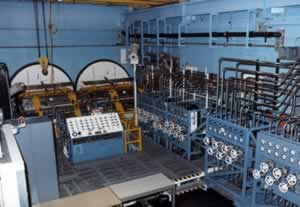 |
| Mid-Infrared Advanced Chemical Laser (MIRACL)
The Mid-Infrared Advanced Chemical Laser (MIRACL) is the first megawatt-class, continuous wave, chemical laser built in the free world. It is a deuterium fluoride (DF) chemical laser with energy spectra distributed among about ten lasing lines between 3.6 and 4.0 microns wavelength. Since it first lased in 1980, it has accumulated well over 3500 seconds of lasing time. To date, it is the only laser produced in the US, at DF wavelength, which has attained average powers at this high level. MIRACL operation is similar to a rocket engine in which a fuel (ethylene, C2H4) is burned with an oxidizer (nitrogen trifluoride, NF3). Free, excited fluorine atoms are one of the combustion products. Just downstream from the combustor, deuterium and helium are injected into the exhaust. Deuterium reacts with the fluorine to yield excited deuterium fluoride (DF) molecules, while the helium stabilizes the reaction and controls the temperature. The laser's resonator mirrors are mounted outside the excited reaction gas region and optical energy is extracted. The cavity is actively cooled and can be run until the consumable supply is exhausted.
Lasing occurs between the cavity's concave and convex resonator optics arranged in a confocal unstable configuration. Outcoupling of the optical energy is accomplished by a scraper mirror which is set at an angle of 45 degrees to the optical axis of the cavity. Next, the laser beam is reflected through a three-element beam-shaping telescope and an aerodynamic window to pass the beam from the cavity pressure to atmospheric pressure. The optical path between the cavity and the beam director has 11 high power mirrors. The path is conditioned with Argon or Nitrogen gas to prevent thermal beam distortion. A low efficiency line grating on a relay optic is used to provide a small sample of the MIRACL's beam to a suite of beam diagnostic instrumentation, and to angle measurement sensors for automatic alignment of the beam. The angle measurement is made by two quad detectors; one for the MIRACL beam, the other for a helium-neon pilot beam. The beam-angle detectors drive steering mirrors to maintain proper alignment of the resonator and the optical train mirrors. The helium-neon detector also senses the alignment of a separate tower alignment beam from the beam director and drives a steering mirror at the base of the SLBD's tower. This Tower Beam Alignment System (TBAS) maintains the high energy laser beam alignment to the Sea Lite Beam Director. In this way, the entire optical train is maintained in alignment from end to end. |
|
For additional information, please e-mail, visit White Sands Missile Range, or mail to: Deputy
Commander, U.S. Army Space and Missile Defense Command
|
| FAIR USE NOTICE: This page contains copyrighted material the use of which has not been specifically authorized by the copyright owner. Pegasus Research Consortium distributes this material without profit to those who have expressed a prior interest in receiving the included information for research and educational purposes. We believe this constitutes a fair use of any such copyrighted material as provided for in 17 U.S.C § 107. If you wish to use copyrighted material from this site for purposes of your own that go beyond fair use, you must obtain permission from the copyright owner. |
|
|
